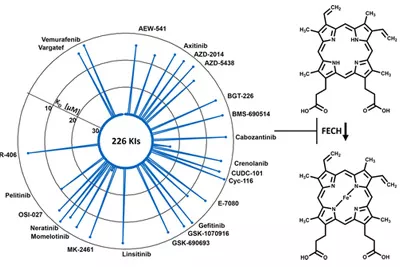Many protein kinases are valid drug targets in oncology because they are key components of signal transduction pathways. The number of clinical kinase inhibitors is on the rise, but these molecules often exhibit polypharmacology, potentially eliciting desired and toxic effects. Therefore, a comprehensive assessment of a compound’s target space is desirable for a better understanding of its biological effects. The enzyme ferrochelatase (FECH) catalyzes the conversion of protoporphyrin IX into heme and was recently found to be an off-target of the BRAF inhibitor Vemurafenib, likely explaining the phototoxicity associated with this drug in melanoma patients. This raises the question of whether FECH binding is a more general feature of kinase inhibitors. To address this, we applied a chemical proteomics approach using kinobeads to evaluate 226 clinical kinase inhibitors for their ability to bind FECH. Surprisingly, low or submicromolar FECH binding was detected for 29 of all compounds tested and isothermal dose response measurements confirmed target engagement in cells. We also show that Vemurafenib, Linsitinib, Neratinib, and MK-2461 reduce heme levels in K562 cells, verifying that drug binding leads to a loss of FECH activity. Further biochemical and docking experiments identified the protoporphyrin pocket in FECH as one major drug binding site. Since the genetic loss of FECH activity leads to photosensitivity in humans, our data strongly suggest that FECH inhibition by kinase inhibitors is the molecular mechanism triggering photosensitivity in patients. We therefore suggest that a FECH assay should generally be part of the preclinical molecular toxicology package for the development of kinase inhibitors.
NEWS - ARCHIVE
Chemical Proteomics Reveals Ferrochelatase as a Common Off-target of Kinase Inhibitors
